Mobile apps are in great demand right from shopping apps and food delivery apps to utility apps. The mobile app development sector is continuously developing, making the lives of consumers smoother.
Below graph shows the total number of mobile apps available on Google Play Store and Apple App Store as of 3rd quarter of 2018.

Mobile app revenues are expected to reach 188.9 billion US dollars by 2020.
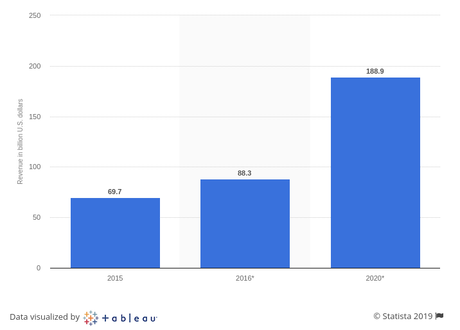
By looking at the above graphs, it is clearly visible that mobile app development scape is growing rapidly. With the advent of technologies like Internet of Things, Blockchain, Wearables, and AR/VR, mobile app development trends are expected to revolutionize the use of smartphones in the upcoming years.
This post highlights the top mobile app trends for 2019, some of which were in trend in 2018 as well, to help you be a front-runner and beat the competition.
- Internet of Things (IoT):
Internet of Things is one of the most advanced technologies having created a buzz around the world. IDC forecasts worldwide technology spending on the Internet of Things to reach $1.2 Trillion in 2022. IoT is being used in varied industry verticals including e-commerce, education, real estate, transportation, healthcare, etc.To build an ecosystem of connected devices, mobility solutions are crucial. Smart cities and smart hospitals connected with mobile apps increase the convenience of users, making it easier for them to operate mobile-connected smart devices. Mobile apps can provide you with a smarter environment at anyplace you are. In the coming future, IoT will make it possible for users to control their household things through their mobile devices. It is one of those mobile app development trends that is expected to rule 2019, helping businesses expedite operations and eliminate expenses.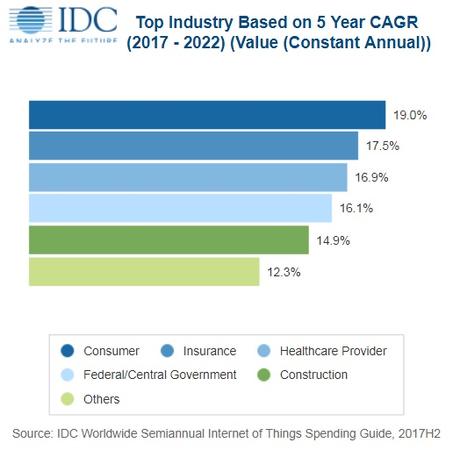
- Augmented Reality:
Augmented Reality (AR) is the new trend being adopted by the mobile app development sector. Zion Market Research predicts AR alone to reach $133 billion by 2021.Pokemon Go game is an amazing example of AR. Instagram and Snapchat too use AR technology having filters to turn a human face into a digital character. Apple is providing a platform for developers to build AR apps using ARKit. Augmented Reality can enhance user engagement when integrated with clothing brands, online stores, or furniture stores. It helps marketers to promote their campaigns and target their audience through mobile apps. Mobile app developers will use AR technology in the coming years to provide a better user experience.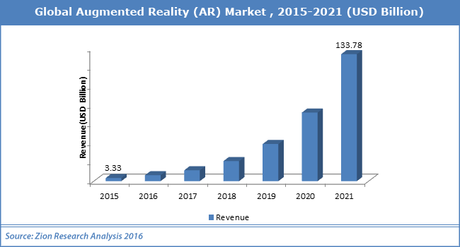
- On-demand apps:
On-demand apps are growing rapidly. They provide a quick and personalized experience to consumers and make users avail services at their convenience. They cater to various businesses including grocery, transportation, travel, healthcare, food, professional services, etc.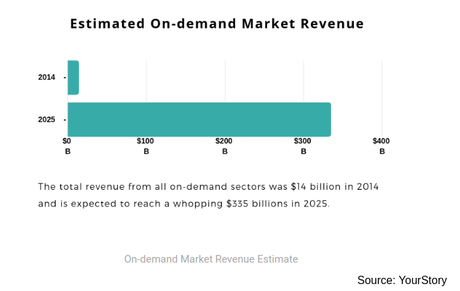
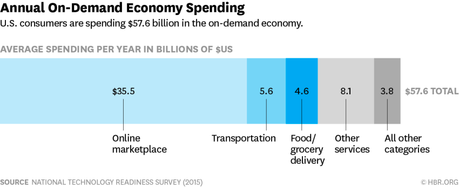
The on-demand economy has a huge revenue potential, making appreneurs avail this lucrative opportunity. The on-demand trend is here to stay and is not expected to fade away anytime soon. - AI and Machine Learning:
Artificial Intelligence (AI) involves creating intelligent machines that work like humans. According to IDC, worldwide spending on Cognitive and Artificial Intelligence systems is forecast to reach $77.6 Billion in 2022. Using Artificial Intelligence (AI) in mobile apps helps in automation of reasoning, giving suggestions, making predictions, etc. They make the life of people easier. Some of the examples of AI and Machine Learning include Apple’s Siri, Microsoft’s Cortana, Alexa, SwiftKey AI, and more. AI and Machine Learning incorporated in a mobile app can give valuable actionable insights about users’ behavior, their buying patterns, browsing history, and other important details to send them personalized offers. Through these mobile apps, you can target your customers in a better way, reduce operational expenses, and enhance your ROI. Global revenues from AI for enterprise applications is projected to grow from $1.62B in 2018 to $31.2B in 2025 attaining a 52.59% CAGR in the forecast period.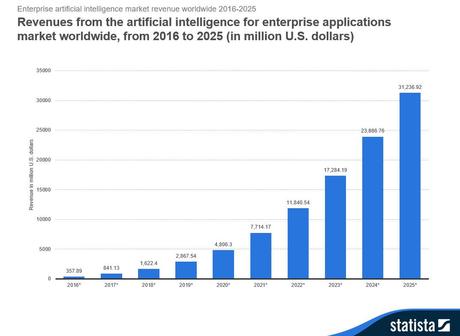
- Chatbots:
Chatbots are widely used in mobile apps to communicate with the users and respond to them in real-time, avoiding human-to-human interaction. They are a good solution for customer service and help connect with the users in a better way. Chatbots enable users to make effective buying decisions by chatting with them. The below graph shows the size of the chatbot market worldwide, in 2016 and 2025.
Chatbots save time and resources of a company by dealing with most of the customer interactions, giving personalized responses to the users 24/7. They are useful for tracking orders, resolving the complaints of customers, and providing answers to the FAQs and product information. Chatbots will power 85 percent of all customer service interactions by the year 2020. The conversational interface of the mobile apps integrated with chatbots increases user engagement and the adoption rate of the app. We will see more chatbots providing smooth customer service in 2019.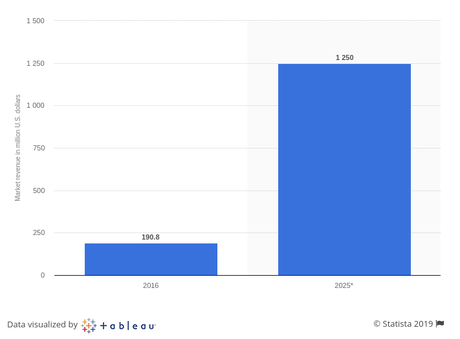
- Instant apps:
Apps installed in the mobile devices can occupy storage, which may result in slow performance of the smartphones. This gave rise to the popularity of instant apps, being introduced in 2016 by Google. Instant apps are stripped down version of an app, smaller in size and not requiring installation. They ensure short load times and reduce bounce rate, offering convenience and a superior experience to users. Some of the examples of Instant apps include New York Times Crossword, Red Bull TV, OneFootball, BuzzFeed, Skyscanner, etc. When Vimeo provided instant app support, there was an increase in its session duration by 130%. The instant apps trend will be welcome in 2019 as well. - Mobile payments:
Mobile payment is one of the hot favorite mobile app development trends for 2019. It is now being preferred over Debit and Credit cards. It is convenient for users and is a smarter way to pay directly from smartphones. It ensures seamless financial transactions with secure encryption capabilities. According to BI mobile payments report 2017, in-store mobile payments are expected to reach $503 billion by 2020. Google Pay Service, for example, allows you to directly pay from the cards saved to your Google account. Other examples include Apple Pay, Samsung Pay, etc. - Wearables:
According to Gartner, worldwide wearable device sales is expected to reach 225 million in 2019, an increase of 25.8 percent from 2018. Wearable devices are synchronized with the smartphones these days, requiring apps in both of them that can be paired and should have close proximity. These apps, for example, give information about the heart rate, amount of cholesterol, and blood sugar levels in the patients. Apart from healthcare, these apps also impact industries like fitness, fashion, education, etc. When users do workouts, wearable apps send data about the distance covered and calories burnt. This has opened a new market for mobile app development, and the wearables trend won’t get outdated soon. - Blockchain:
According to IDC, worldwide spending on blockchain is forecast to reach $11.7 billion in 2022. With the use of blockchain, Decentralized apps (Dapps) can be developed that can’t be owned or shut down and don’t have any downtime. They are completely open-source, cryptographically stored, and use a cryptographic token. They are highly secure and ensure cost-effectiveness. Various industry verticals including financial services, retail, and healthcare are leveraging blockchain technology to build mobile apps. Some of the examples of Dapp include Augur, Brave, Aragon, Ethlance, Akasha, etc. The blockchain technology is gradually evolving, so is the Decentralized apps trend, which is going to be one of the top trends to watch in 2019. - Cloud applications:
2019’s mobile app trends include cloud-based apps as well. As per Cisco VNI International Mobile Forecast, in 2014, cloud applications accounted for 81 percent of total mobile data traffic; by 2019, cloud applications will account for 90 percent of the total mobile data traffic. Smartphones generally have limitations on storage, which is addressed by Cloud-based apps having no storage issues. These apps not only have unlimited storage but also enhance productivity and ensure a flawless performance. The apps are easily accessible from multiple devices and are secure, delivering a seamless user experience on various devices and reducing the cost of hosting. Some of the examples of Cloud apps used widely include Evernote, Dropbox, Gmail, Amazon Web Services, etc.
Winding it up
We end this topic here with the note that the technology sector is expanding and mobile app development will witness a lot more innovation in 2019. The mobile app trends are improving several aspects of our lives along with enhancing the user experience. Mobile app developers will, therefore, have to keep themselves updated with the latest tools and technologies.
Mobile apps that have elegant design, smooth navigation, and user-friendly features are demanded the most. Creating such an app is a herculean task, requiring the help of experts in this field who can follow the latest mobile app development trends.
MintTM has proficiency in mobile app development having a team of dexterous developers, who will embrace the above trends and cater to all your app needs. Don’t hesitate to contact us at [email protected]. We will help you in meeting your ever-changing demands and beat the competition through our mobile apps.
